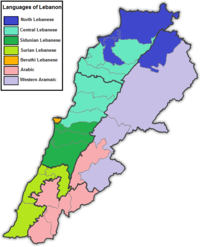Lebanese
| Lebanese | |
|---|---|
| 𐤃𐤁𐤓𐤉𐤌 𐤋𐤁𐤍𐤉𐤌 dabarīm labonīm | |
 | |
| Pronunciation | [/da.ba.ˈriːm la.boː.ˈniːm/] |
| Created by | Raistas |
| Setting | Parallel Earth |
| Native to | Lebanon |
| Native speakers | 6.1 million (2015) |
Afro-Asiatic
| |
Early forms | |
The Lebanese language (Lebanese: 𐤃𐤁𐤓𐤉𐤌 𐤋𐤁𐤍𐤉𐤌, dabarīm labōnīm) is a Northwest Semitic language, native to and spoken primarily in Lebanon. Lebanese and Hebrew are the only Canaanite languges still spoken. Modern Lebanese is the official language of the Lebanese Republic, however other languages like Arabic and Western Aramaic have a special status as regional languages with their native speakers speaking Lebanese as a second language. Since a majority of the Lebanese people are bilingual or trilingual, it is not uncommon for them to mix Lebanese, Arabic, English or French into their daily speech.
Lebanese is descended from the Phoenician language originally spoken in the coastal region of Levant called 𐤐𐤕 Pūth. Phoenician had almost ceased to be a written language somewhere between 900 and 1400 CE, being slowly replaced by Arabic. With the rise of nationalism in the 19th century, it was revived as a literary language, becoming modern standard Lebanese.
Etymology
The modern name "Lebanese" comes from the word 𐤋𐤁𐤍 labōn, meaning "white", apparently from its snow-capped peaks of the Mount Lebanon range (𐤄𐤓𐤉 𐤄𐤋𐤁𐤍𐤅𐤍 horē ha-labōnūn). The name was introduced in the 19th century, however, some occurences of this name have been found in the 17th century texts, though it is unclear whether the name referred to the Lebanese language or one of its dialects. Before that the language was called Phoenician (𐤐𐤕𐤉𐤌 pūttīm) or simply Canaanite (𐤊𐤍𐤏𐤍𐤉𐤌 kanaʿanīm). The etymology of these names is uncertain.
History
Lebanese belongs to the Canaanite group, which itself is a branch of the Northwest Semitic family of languages. Its direct ancestor is called the Phoenician language. In its widest sense, Old Phoenician refers to the spoken language of Northern Levant in a wide range between the 10th century BCE and the turn of the 7th century CE, when it was being replaced by other local languages, mostly by Arabic.
From a traditional linguistic perspective, Phoenician was composed of a variety of dialects. However, the insufficient records of the time make it unclear whether Phoenician formed a separate and united dialect or was a part of a broader language continuum. Punic colonisation spread Phoenician to the western Mediterranean, where the distinct Punic language (𐤃𐤁𐤓𐤉𐤌 𐤐𐤍𐤉𐤌 dabarīm pūnnim) developed. It underwent some phonological and lexical changes as it spread among the North-African peoples. Most notable changes were the loss of laryngeals (/ħ/, /ʕ/, /ʔ/ and /h/) and the coalescence of sibilants into /s/. In the Roman period Punic remained the spoken language of the majority of the African population and other regions nearby. Punic died out, it seems to have survived into the 9th century AD. Today there are a number of common Berber words that descend from it.
Old Phoenician
The Phoenicians were the first state-level society that had an extensive use of the Semitic alphabet. The Phoenician alphabet is the oldest verified consonantal alphabet, or abjad. The Phoenician alphabet is generally believed to be at least the partial ancestor of almost all modern alphabets.
In Phoenician writing, unlike that of abjads such as those of Aramaic, Biblical Hebrew and Arabic, even long vowels remained generally unexpressed, regardless of their origin (even if they originated from diphthongs, as in 𐤕𐤁 /beːt/ (modern /beːθ/, "house"). Eventually, writers began to implement systems of marking of vowels by means of matres lectionis. In the 3rd century BC appeared the practice of using final "𐤀" ('ālp) to mark the presence of any final vowel and, occasionally, of "𐤉" (yōd) to mark a final long [iː] and "𐤅" (wāw). for [uː].
Both in Punic and in Old Phoenician the voiceless stop consonants started developing fricative allophones (probably under the influence of Aramaic for Phoenician and the influence of Berber for Punic), and these sounds eventually became phonemic in Phoenician. Those were likely parallel processes since the contact between the two varieties was weak during this period. A simialr process occured in Hebrew, but it involved voiced stops as well.
Middle Age Phoenician
Since the 3rd century AD Western Aramaic has started being spoken in the region. Following the early Muslim conquests of the 7th century and the cultural and linguistic Arabization of the Levant, Arabic gradually started displacing Phoenician (and Aramaic) as the first language of most people. Despite this, Phoenician have survived for a relatively long time in many villages of the Mount Lebanon area. In fact, up until the seventeenth century, travelers to the Lebanese cities still reported a few Phoenician speakers there, even though people in the cities spoke almost exclusively in Arabic. In the 11th century the Crusades were launched in Western Europe to reclaim the former Byzantine Christian territories. These crusader states made a lasting impact on the region as many Phoenicians became Christians and many religion related loanwords entered their language during this period. Also during this time many Phoenisians started settling on Malta and Greek islands, bringing their language with them. These communities were later assimilated, however they had an impact on the Maltese language